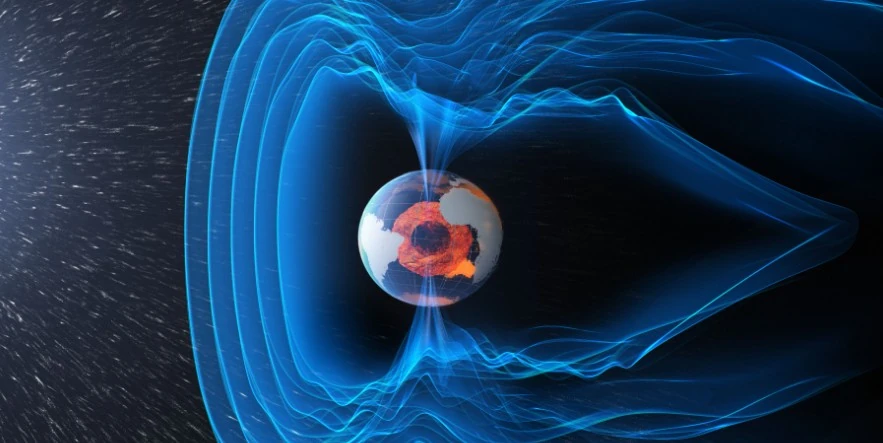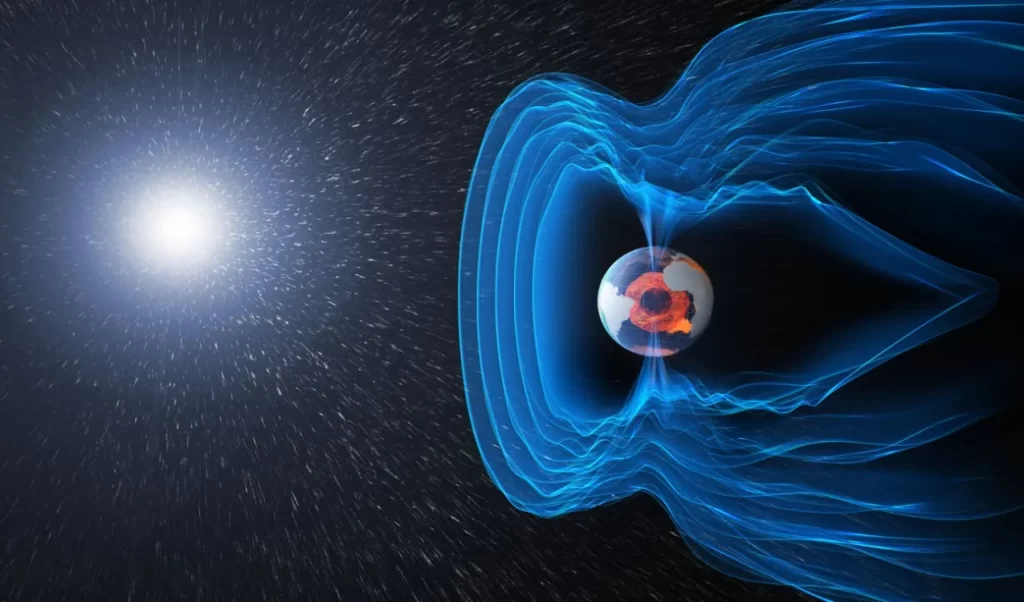Decade of Swarm satellite data unveils new insights into Earth’s magnetic field and core dynamics

Launched in 2013, the European Space Agency’s (ESA) Swarm mission, consisting of three satellites, has provided a decade of invaluable data on Earth’s magnetic field and enabled significant advances in understanding the mechanisms behind its slow changes. Researchers have utilized this extensive dataset, alongside advanced numerical simulations, to derive new insights into the swirling motion of liquid iron in Earth’s outer core and its impact on the magnetic field. The findings, including the identification of a core jet stream and magnetic waves, contribute to improving predictions of future magnetic field fluctuations.
The importance of the Earth’s magnetic field goes beyond the immediate benefits of radiation protection and technological support. It is intricately linked to the broader environmental and climate systems that define our planet’s habitability.
The geomagnetic field plays a crucial role in preserving Earth’s atmosphere and, by extension, the conditions necessary for life. It acts as a defense mechanism against the harmful radiation and energetic material that our Sun emits, ensuring that the planet’s surface remains hospitable to biological life.
Understanding the dynamics of Earth’s magnetic field is also important for the preservation of our technological infrastructure and our current way of life. It greatly influences navigation and satellite operations and is crucial for essential services such as global positioning systems (GPS), telecommunications, and weather forecasting. These services are integral to daily activities, economic operations, and emergency responses, among others.
Moreover, the study of Earth’s magnetic field offers a window into the past, providing scientists with clues about the planet’s formation, the evolution of its core, and the historical shifts in climate and magnetic orientation. These insights are crucial for understanding the long-term stability of Earth’s environment and preparing for future changes. For example, magnetic field studies can help predict the occurrence of magnetic pole reversals and their potential impact on global systems.
The current observations of weakening in the Earth’s magnetic field, particularly in regions like the South Atlantic Anomaly, underscore the urgency of monitoring and understanding these changes. As the field weakens, the protection it offers against solar radiation decreases, posing a risk not only to satellites and technological systems but potentially to the atmosphere itself. This could have far-reaching consequences for the planet’s climate, weather patterns, and the overall stability of the biosphere.
In light of these factors, the global scientific community is intensifying its efforts to study the magnetic field and projects like ESA’s Swarm mission are at the forefront of this research, employing advanced satellite technology to map the magnetic field’s fluctuations in unprecedented detail. These efforts are crucial for developing predictive models that can anticipate changes in the magnetic field and their implications for Earth’s environment and human society.
The significance of Earth’s magnetic field, therefore, cannot be overstated. As we deepen our understanding of this fundamental force, we are better equipped to protect our planet, harness the benefits of our technological advancements, and prepare for the challenges that changes in the magnetic field may bring.

ESA launched the Earth Explorer Swarm mission, a trio of identical satellites designed to study Earth’s magnetic field with unprecedented detail, in November 2013. Over the past ten years, this mission has transformed our understanding of the magnetic shield that protects our planet from the solar wind’s harmful effects. The Swarm constellation, with two satellites flying in close formation and a third at a different altitude, achieves comprehensive spatial coverage of magnetic field data within a single day, facilitating a global perspective on how the magnetic field changes over time.
“An impressive ten years of Swarm data now provide us with a reliable, global picture of how Earth’s magnetic field is changing,” said Chris Finlay, from the Technical University of Denmark. This decade-long observation period has been crucial for dissecting the slow variations in the magnetic field, primarily generated in Earth’s core, over years to decades.
The “Swarm+ 4D Deep Earth Core” project, an initiative under ESA’s Earth Observation Science for Society program, has played an important role in advancing our knowledge of Earth’s core dynamics. The project leveraged Swarm data alongside advanced numerical simulations to create detailed maps illustrating the global structure and gradual changes of Earth’s magnetic field. These maps trace the magnetic field back to its source in the outer core, where swirling, conductive liquid iron generates the magnetic field through its movement.
One of the significant discoveries made through this research was a jet stream under the Bering Strait, where core flow speeds increase markedly, moving at about 10 km (6.2 miles) per year, roughly three times faster than typical core movements.
The project has identified faster processes within the core, such as disturbances in the liquid iron that cause magnetic field waves. These waves are essential for predicting future changes in the magnetic field, offering insights that could enhance forecasting abilities a few years into the future.
Many scientists are using Swarm data to gain a better understanding of the ‘South Atlantic Anomaly’ — an area stretching from Africa to South America, where Earth’s magnetic field is gradually weakening. “This strange behavior has geophysicists puzzled and is causing technical disturbances in satellites orbiting Earth,” ESA reported in 2020.
Over the last 200 years, the magnetic field has lost around 9% of its strength on a global average and a large region of reduced magnetic intensity has developed between Africa and South America — known as the South Atlantic Anomaly.
Between 1970 and 2020, the minimum field strength in this area decreased from approximately 24 000 nanoteslas to 22 000 nanoteslas, ESA said. Concurrently, the anomaly has expanded and shifted westward at a rate of about 20 km (12.4 miles) per year. Notably, from 2015 to 2020, a second center of minimum intensity appeared southwest of Africa, suggesting the possibility that the South Atlantic Anomaly may divide into two distinct cells.
This anomaly challenged the traditional dipolar model of Earth’s magnetic field, which is often conceptualized as a giant bar magnet tilted about 11° from the planet’s rotational axis. The emergence of the second minimum intensity center indicated that the mechanisms generating Earth’s magnetic field are more intricate than previously understood.
The Swarm Data, Innovation, and Science Cluster (DISC) utilizes the ESA’s Swarm satellite constellation to delve deeper into the nature of this anomaly. These satellites are specifically equipped to dissect and accurately measure the various magnetic signals constituting Earth’s magnetic field.
The current weakening of the magnetic field has led to speculation about a potential imminent geomagnetic reversal, a phenomenon where the Earth’s magnetic north and south poles would exchange places.
Historical records reveal that these reversals have taken place intermittently, averaging once every 250 000 years. Given this frequency, a growing number of researchers contend that Earth might be approaching the threshold for another reversal. This subject, vast and significant, extends well beyond the scope of this piece. However, for those of you intrigued by the complexities of Earth’s magnetic dynamics, it presents a compelling field of study, deserving of deeper investigation.
For satellites and spacecraft traversing the South Atlantic Anomaly, the reduced magnetic field strength poses a heightened risk of technical issues due to increased penetration of charged particles at the altitudes of low-Earth orbit satellites.
The upcoming Swarm 10 Year Anniversary Science Conference in Copenhagen in April 2024 will celebrate the mission’s achievements and its impact on our comprehension of Earth’s magnetic field and core dynamics.
References:
1 Ten years of Swarm data help reveal processes in Earth’s core – ESA – March 26, 2024
2 Swarm probes weakening of Earth’s magnetic field – ESA – May 20, 2020
Featured image credit: ESA



The Weakening of Earth’s Magnetic Field is the Reason for the Rapid Warming of the Arctic and Atlantic Ocean
This is my upcoming article. Read the abstract
Earlier studies estimated that the Arctic region is warming around twice as fast as the global average. Yet, recent studies have found this figure to be wrong by a huge margin (hugely underestimated). Actually, in the last 45 years, the Arctic region has warmed almost 4 times faster than the rest of the planet. On the other hand, since 2016 the Atlantic Ocean, especially its Northern part, has warmed faster than other ocean basins in the top 100 meters of ocean. Nonetheless, the real reason for the rapid warming of the Arctic and the Atlantic Ocean is because Earth’s magnetic field around these regions weakened more compared to other regions. Specifically, the biggest decline in the strength of Earth’s magnetic field was around the Arctic regions, the North Atlantic Ocean and also within the South Atlantic, as the South Atlantic Anomaly shows. The decline in the strength of Earth’s magnetic field, definitely implies that these regions would receive more solar radiation than when the field was strong and stable. Thus, one can say conclusively, that the rapid weakening of Earth’s magnetic field around the Arctic regions and the Atlantic Ocean in general, was the fundamental cause, why these regions warmed faster in comparison to other regions of the planet.
The Weakening of Earth’s Magnetic Field is the Reason for the Rapid Warming of the Arctic and Atlantic Ocean.
This is my upcoming article and it will be ready in the next two days. Here is the Abstract.
Earlier studies estimated that the Arctic region is warming around twice as fast as the global average. Yet, recent studies have found this figure to be wrong by a huge margin (hugely underestimated). Actually, in the last 45 years, the Arctic region has warmed almost 4 times faster than the rest of the planet. On the other hand, since 2016 the Atlantic Ocean, especially its Northern part, has warmed faster than other ocean basins in the top 100 meters of ocean. Nonetheless, the real reason for the rapid warming of the Arctic and the Atlantic Ocean is because Earth’s magnetic field around these regions weakened more compared to other regions. Specifically, the biggest decline in the strength of Earth’s magnetic field was around the Arctic regions, the North Atlantic Ocean and also within the South Atlantic, as the South Atlantic Anomaly shows. The decline in the strength of Earth’s magnetic field, definitely implies that these regions would receive more solar radiation than when the field was strong and stable. Thus, one can say conclusively, that the rapid weakening of Earth’s magnetic field around the Arctic regions and the Atlantic Ocean in general, was the fundamental cause, why these regions warmed faster in comparison to other regions of the planet.